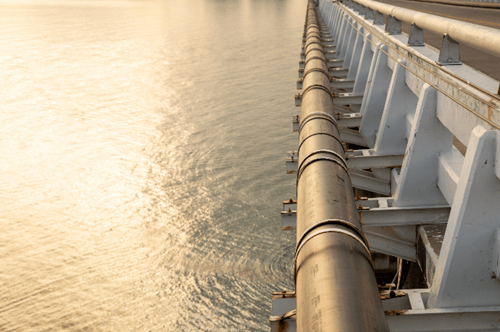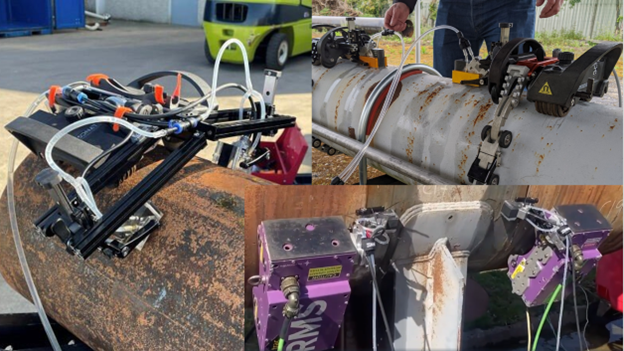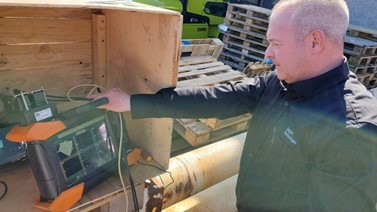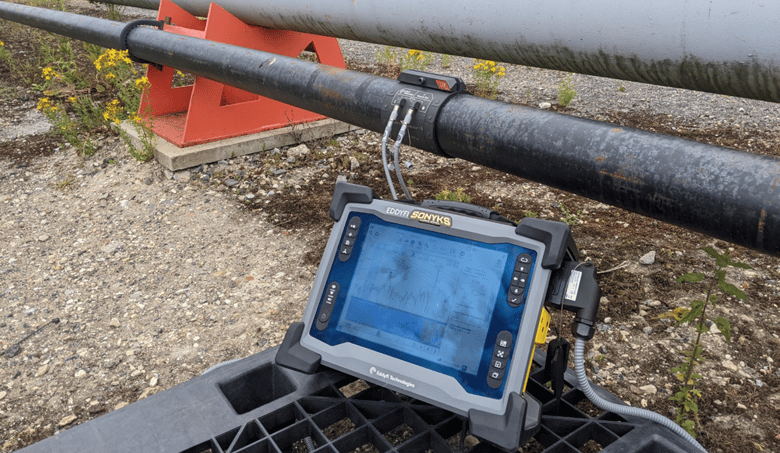Eddyfi Technologies offers two techniques that are considered complementary to each other for pipe support inspection:
-
Phased array ultrasonic testing (PAUT) with the LYNCS™ or RMS scanners
-
Medium range ultrasonic testing (MRUT) using the Sonyks™ and high frequency Magneto-tools.
How Corrosion Under Pipe Supports Forms
Support locations such as brackets and clamps tend to act as entrapment areas for water and other liquids that can result in corrosion. This type of corrosion is highly localized and can result in pits and other forms of damage often occurring due to a lack of proper inspection and maintenance of the affected areas. Water often gets trapped between the support and pipe or vessel, forming ideal conditions for localized crevice corrosion. As the paint/coating system fails, corrosion attacks the metal component; therefore, it is imperative to perform regular condition monitoring to ensure detection before catastrophic failure.
PAUT Scanners for CUPS
Initially, visual inspections are performed to identify areas of interest, followed traditionally by radiographic testing (RT) or ultrasonic testing (UT) tools using electromagnetic acoustic transducers and/or guided wave testing (GWT) (like this one). However, technological developments offer more advanced techniques with greater detail and accuracy.
First, we will look at the technique used for inspecting CUPS using PAUT in combination with either the RMS PA or LYNCS™ NDT scanners for measuring wall loss within the pipe support area. The technique transmits ultrasound from one side of the pipe support, receiving the signal at the other side, and the scanner allows this signal to be tracked with distance either travelling axially along the pipe or circumferentially around the pipe.


The geometry of the pipe support dictates how the inspection is carried out. For example, if the pipe support were a common U-bolt clamp type support, access across the top of the pipe is not possible without removing the clamp; therefore, the scanner moving circumferentially around the pipe would be preferable. For saddle type supports it may be quicker and easier for the scanner to travel axially along the pipe to do the inspection. Both options are available with Eddyfi Technologies products and have been applied in the field.

Figure 1: Various possible scanning configurations using both the LYNCS and RMS scanners
Offering data in specific formats is key to streamlining an inspection process, and Gekko® data acquisition software, Capture™, enables inspectors to do just that; it is easily exported in the correct file format for use with both third-party packages of PA-CAT (Holloway NDT and Engineering Inc.) and/or PA M-SKIP (ESR Technology). The results from internal and external studies have found both post-processing algorithms to be within the stated specifications of the techniques.

GWT for CUPS
The second technique is a screening technique utilizing the Sonyks™ guided wave testing instrument with its high frequency (128kHz) Magneto-tools. Recently launched by Eddyfi Technologies, the high frequency Magneto-tools are extremely sensitive to changes in cross-sectional area loss, particularly when inspecting over a short length of 10 meters (32.9 feet) or less. When you combine this with the ease at which the new Sonyks instrument collects data, the interpretation being done on the touchscreen of the unit allows for a very quick and cost-effective screening method for detecting corrosion under pipe supports.

Figure 2: Sonyks and Magneto-tool inspecting the pipe support
The Magneto-tools are extremely low profile, easy to install —and in combination with Sonyks with the interpretation software on the touchscreen— inspection of the pipe support takes a matter of minutes. This is effective especially when screening several pipe supports for corrosion. The data not only gives amplitude of the response but also circumferential information on the defect through both the C-Scan imaging and focusing.
Eddyfi Technologies Has Your Inspection Needs Covered
We are committed to delivering the most synergistic solutions across our broad product offering to help detect defects left otherwise unknown. How can we help you improve your inspection program? Contact our NDT experts to discuss your specific requirements today!
Authors: Paul Jackson, Stuart Kenny




